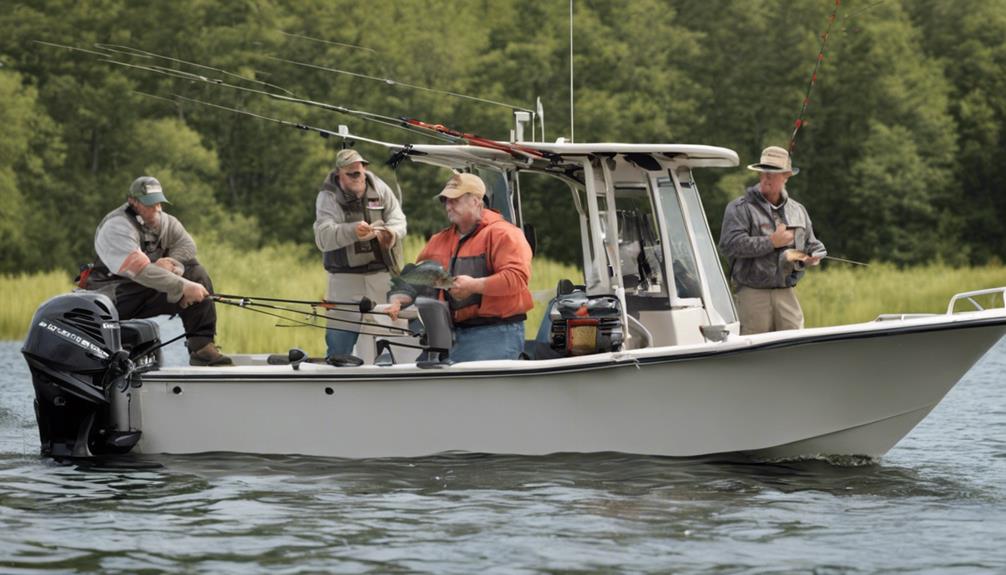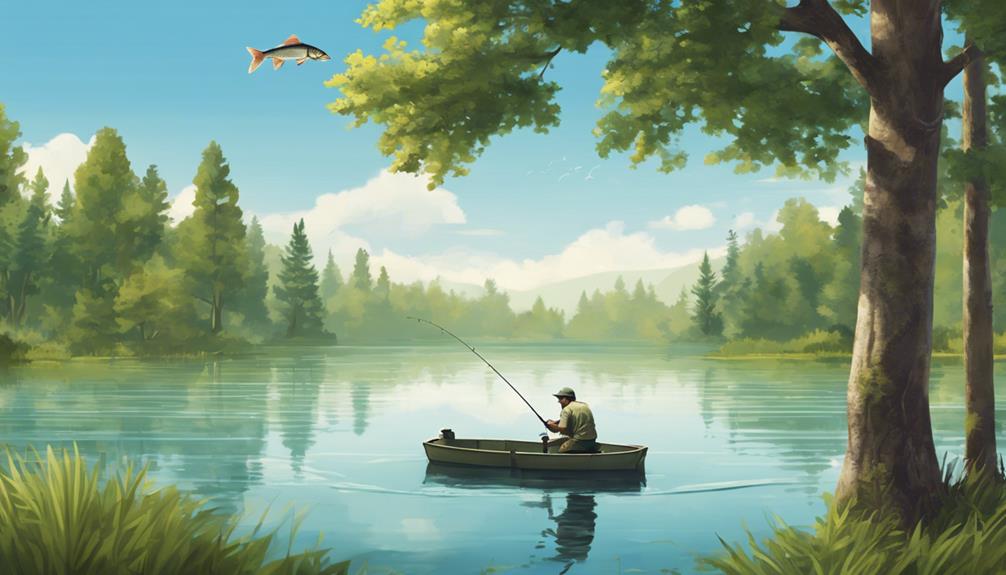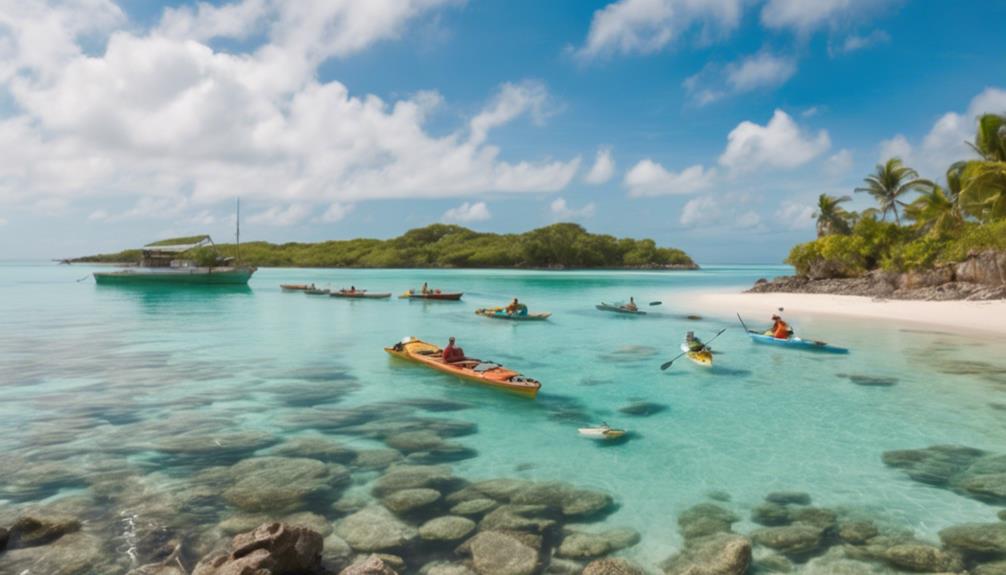Have you ever considered how simple modifications to your fishing gear could significantly impact marine conservation efforts?
Imagine a world where every angler prioritizes the environment while enjoying their favorite pastime.
By implementing small changes to your gear, you can actively contribute to the health of our oceans and aquatic ecosystems.
From biodegradable fishing lines to sustainable hook options, the possibilities are endless.
Stay tuned to discover how these conservation-friendly modifications can revolutionize your fishing experience and protect our precious marine life.
Biodegradable Fishing Lines
When you're considering sustainable fishing practices, opting for biodegradable fishing lines is a simple yet effective way to reduce environmental impact. Eco-conscious anglers understand the importance of using gear that minimizes harm to marine ecosystems. Traditional fishing lines are often made of nylon, which can persist in the environment for hundreds of years, posing a threat to marine life. By switching to biodegradable fishing lines, you can decrease the amount of plastic pollution in oceans and waterways.
In addition to using biodegradable fishing lines, incorporating reusable tackle into your fishing routine can further enhance your eco-friendly practices. Reusable tackle refers to gear that can be used multiple times, reducing the amount of waste generated during fishing trips. Instead of using single-use items that end up in landfills or oceans, eco-conscious anglers opt for durable, long-lasting tackle that can withstand multiple uses.
Non-Toxic Fishing Weights
Switching to non-toxic fishing weights is another crucial step in minimizing environmental impact while fishing, complementing the use of biodegradable fishing lines. By opting for eco-friendly alternatives and lead-free options, you can significantly reduce the harm caused to aquatic ecosystems. Here are some benefits and considerations to keep in mind:
- Environmental Protection: Non-toxic fishing weights help prevent the leaching of harmful substances into water bodies, safeguarding marine life and habitats.
- Healthier Ecosystems: By choosing lead-free options, you contribute to the well-being of fish populations and overall aquatic biodiversity.
- Compliance with Regulations: Using non-toxic weights ensures that you adhere to environmental regulations, promoting sustainable fishing practices.
- Reduced Contamination: Lead weights can contaminate water sources, affecting not only aquatic organisms but also potentially entering the food chain.
- Long-term Sustainability: Incorporating non-toxic fishing weights into your gear promotes a more sustainable approach to angling, supporting the health of the environment for future generations.
Making the switch to non-toxic fishing weights is a simple yet impactful way to minimize your ecological footprint while enjoying the sport. By choosing lead-free alternatives, you actively contribute to the conservation of marine environments and help preserve the delicate balance of aquatic ecosystems.
Selective Fishing Gear Designs
To enhance conservation efforts in fishing practices, consider incorporating selective fishing gear designs that target specific species. By using eco-friendly mesh and sustainable traps, you can significantly reduce bycatch and help preserve marine ecosystems. Eco-friendly mesh, made from biodegradable materials or designed to allow smaller or non-targeted species to escape, can greatly minimize unintended catches. These meshes are durable and effective at catching the desired species while being gentle on the environment.
Sustainable traps are another innovative approach to selective fishing gear designs. These traps are designed to attract specific species while deterring others, reducing the impact on non-targeted populations. By using bait or pheromones that only appeal to the desired species, sustainable traps can help fishermen catch their target while avoiding the capture of unwanted marine life. Additionally, these traps are often designed to be reusable, reducing waste and promoting a more sustainable fishing industry.
Incorporating these selective fishing gear designs into your fishing practices can have a positive impact on marine conservation. By reducing bycatch and minimizing harm to non-targeted species, you can contribute to the preservation of marine biodiversity. Consider investing in eco-friendly mesh and sustainable traps to make your fishing gear more conservation-friendly and environmentally responsible.
Reduction of Ghost Gear
Consider implementing strategies to reduce ghost gear in your fishing practices to minimize harm to marine life and ecosystems. Ghost gear, abandoned, lost, or discarded fishing gear, poses a significant threat to marine environments and wildlife. By actively engaging in ghost gear management and marine debris prevention, you can play a crucial role in protecting our oceans.
Here are some practical steps you can take:
- Regular Gear Checks: Routinely inspect your fishing gear to ensure nothing is lost or abandoned in the water.
- Proper Gear Disposal: Dispose of damaged or unwanted gear responsibly to prevent it from becoming ghost gear.
- Gear Marking, and Recovery: Clearly label your gear with contact information to aid in its recovery if lost.
- Support Retrieval Programs: Participate in or support initiatives that aim to retrieve lost fishing gear from the ocean.
- Educate Others: Spread awareness about the importance of ghost gear management and encourage others to adopt responsible fishing practices.
Minimize Single-Use Plastics
Implementing measures to reduce the consumption of single-use plastics is essential for protecting marine ecosystems and wildlife. When fishing, opt for reusable alternatives to single-use plastics wherever possible. Instead of using disposable plastic bags for storing bait or catch, consider using reusable silicone bags or containers. These alternatives aren't only more durable but also help in reducing plastic waste that often finds its way into the oceans.
Another way to minimize single-use plastics in fishing gear is by choosing products with sustainable packaging. Look for fishing gear that comes in packaging made from recycled materials or is biodegradable. By supporting products with eco-friendly packaging, you contribute to reducing the amount of plastic waste generated from fishing activities.
Additionally, consider investing in reusable water bottles and containers for your fishing trips. Bringing your beverages and snacks in reusable containers can significantly decrease the amount of single-use plastics used during your outings. Small changes like these can have a positive impact on the environment and help in preserving marine life for future generations.
Eco-Friendly Lure Materials
Choosing eco-friendly lure materials is crucial for reducing the environmental impact of fishing activities. When selecting sustainable tackle and eco-conscious bait, you can make a positive contribution to marine conservation efforts.
Here are five eco-friendly lure materials to consider:
- Biodegradable Plastics: Opt for lures made from biodegradable plastics that break down naturally over time, reducing the risk of harming marine life.
- Natural Fibers: Look for lures crafted from natural fibers such as hemp or cotton, which are renewable and have minimal environmental impact.
- Recycled Materials: Choose lures made from recycled materials like recycled metal or plastic, promoting the reuse of resources.
- Wooden Lures: Wooden lures are a sustainable option as they're biodegradable, durable, and have a classic appeal.
- Plant-Based Plastics: Consider lures made from plant-based plastics derived from sources like corn or sugarcane, which are renewable and eco-friendly.
Sustainable Hook Options

When it comes to sustainable fishing practices, one critical aspect to consider is the choice of hooks that minimize harm to marine ecosystems. Opting for barbless hook alternatives is a sustainable option that can help reduce the impact on fish populations. Barbless hooks are designed to make hook removal easier and less damaging, leading to higher survival rates for released fish. By using barbless hooks, you can contribute to the conservation of fish populations while still enjoying the thrill of fishing.
In addition to using barbless hooks, another sustainable hook option is to consider natural bait alternatives. Natural bait options such as worms, insects, or small fish are eco-friendly choices that support the natural diet of target fish species. Using natural bait reduces the need for synthetic or processed baits that may contain harmful chemicals or microplastics. By opting for natural bait options, you can minimize the environmental impact of your fishing activities and promote a more sustainable approach to angling.
Gear Recycling Programs
Have you ever wondered how to responsibly dispose of your old or damaged fishing gear? Gear Recycling Programs offer a sustainable solution that benefits both the environment and the fishing community. By participating in these programs, you can contribute to conservation efforts and promote the recycling of fishing gear.
- Gear Donation: Instead of throwing away your old gear, consider donating it to organizations that can refurbish or recycle it for reuse.
- Community Involvement: Get your local fishing community involved in gear recycling programs to amplify the impact and raise awareness about the importance of responsible gear disposal.
- Environmental Benefits: Recycling fishing gear helps prevent pollution of water bodies and reduces the impact on marine life.
- Resource Conservation: By recycling fishing gear, you contribute to the conservation of resources by extending the life cycle of materials used in gear production.
- Educational Opportunities: Gear recycling programs can also serve as educational platforms to teach anglers about the significance of sustainable practices in fishing.
Frequently Asked Questions
How Do Modifications to Fishing Gear Affect the Overall Health of Marine Ecosystems?
When you modify fishing gear, it directly impacts the health of marine ecosystems. Different gear alterations, such as using biodegradable materials or reducing bycatch, can contribute to better ecosystem health.
Are There Any Regulations or Certifications in Place to Ensure That Conservation-Friendly Fishing Gear Is Being Used?
To ensure conservation-friendly fishing gear is used, regulations and certifications play a crucial role. They promote innovative designs and sustainable practices in the fishing industry.
Can Using Conservation-Friendly Fishing Gear Help Reduce Bycatch of Non-Target Species?
Using conservation-friendly fishing gear can greatly reduce bycatch of non-target species, benefiting ecosystem health. The impact of such modifications extends beyond bycatch reduction, promoting sustainability in fishing practices.
How Do Different Modifications to Fishing Gear Impact the Overall Sustainability of the Fishing Industry?
Making impactful changes to fishing gear can have significant environmental benefits. These modifications can enhance the overall sustainability of the fishing industry by reducing bycatch, minimizing habitat destruction, and promoting ecosystem health.
Implementing gear adjustments such as using circle hooks, modifying trawl nets, and employing devices like TEDs can help achieve these goals. These alterations not only benefit marine life but also contribute to the long-term viability of the fishing industry.
Are There Any Studies or Research That Show the Effectiveness of Conservation-Friendly Fishing Gear in Preserving Marine Biodiversity?
When it comes to conservation impact and biodiversity preservation, studies have shown the effectiveness of conservation-friendly fishing gear in preserving marine biodiversity.
Research indicates that these modifications can significantly reduce bycatch and habitat damage, leading to a healthier marine ecosystem overall.
Conclusion
In conclusion, making modifications to your fishing gear can help contribute to conservation efforts. By switching to biodegradable lines, non-toxic weights, and eco-friendly materials, you can reduce the impact on the environment.
Selective gear designs and recycling programs also play a crucial role in preserving marine ecosystems. Remember, every small change you make can make a big difference in protecting our oceans for future generations.
So, make the switch to conservation-friendly gear today!



